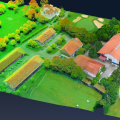
Fuzzy Tolerance has posted a simply incredible time-lapse video taken as the ISS passes over Earth. Maybe while you’re watching it you can pretend you’re in a spaceship preparing to touch down on planet Earth (not that I did that or anything…). Keep your good eye out for the lightning in the clouds. Spectacular!
Very Spatial has a few links out to interesting pieces regarding the declassification of two cold-war era spy satellites. If you like retro espionage as much as you like photos and videos of satellites, then you could do worse than check out the source link.
National Geographic have a story on how the Global Heritage Fund, Google Earth, and DigitalGlobe are using satellite imagery to monitor, protect, and preserve some of the world’s most precious heritage sites, including Angkor Wat, Nineveh, Pompeii and dozens of others.
Onearth posted a story about the latest edition of The Times Comprehensive Atlas of the World, talking about some of the changes to coastlines that have had to be incorporated (particularly in the icy regions) due to climate change.
Some people are saying that the numbers don't stack up, however. Controversy is ongoing.
Some people are saying that the numbers don't stack up, however. Controversy is ongoing.
AnyGeo have an interesting post that talks about a recent research paper published that shows that it’s possible to identify an individual based on three commonly available pieces of information: date of birth, ZIP code (yes, it’s a US study), and gender. Particularly scary when you consider how much of this information is available on social networks.
BigThink have a quaint little map showing the furthest distance that a Eurovision fan will have to travel to attend next year’s event. Yes, this is the first Eurovision-themed map I’ve ever seen.
And, finally, a longer piece to think on. The Easy GIS Blog talks about the way that geography, or at least how we think about geography, is changing in this ‘connected world’, and how GIS is changing because of it.







